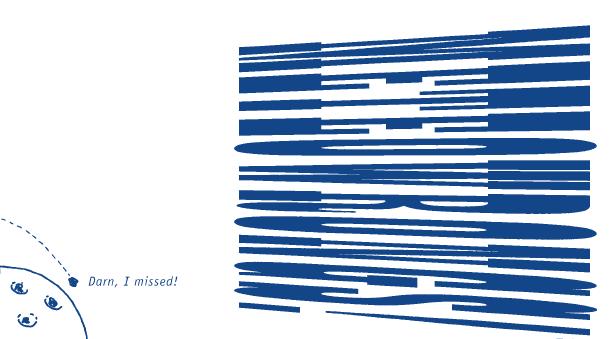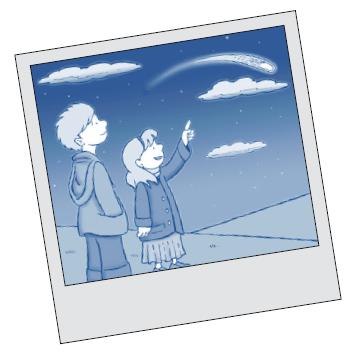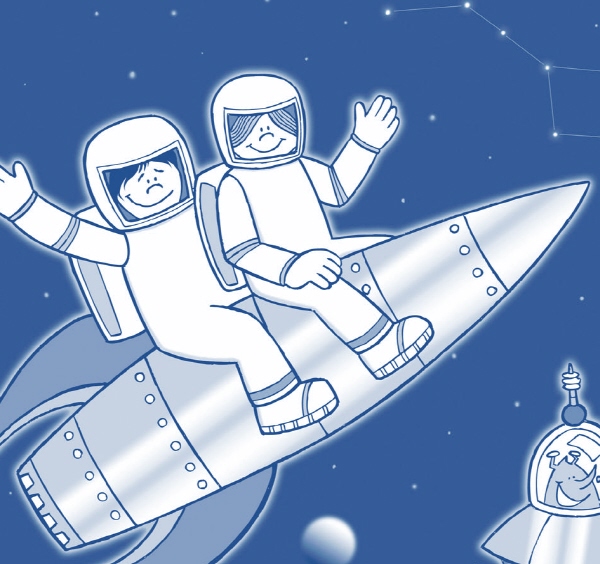Everything Kids' Astronomy Book (5 page)

Just for Fun
Meteorite Collection
Lots of people collect rocks, but how about having a meteorite and rock collection? To start your collection all you will need is a box and a good location to find a few rocks. You will also need a book to help you identify which items are rocks and what may actually be items from space.
Too Close for Comfort
Not all of the asteroids are between Mars and Jupiterâ some actually circle in Jupiter's orbit and others cross Earth's orbit. These are called near-Earth asteroids. Several times during the last hundreds of millions of years on Earth, huge craters were created when these objects reached the planet. Many scientists believe that the shock waves created dust storms, volcanoes, and possibly some 65 million years ago, may have killed off the dinosaurs! There are satellites that continually scan the skies to keep track of where the asteroids are since a planet's gravity can pull them from their orbits. Each asteroid that they find is entered into a computer, so the scientists know where they should be and they continually monitor them to see if they are staying in the same orbit. You can help watch for asteroids outside the belt by using a star map and taking pictures of the sky. If a star seems to disappear, you might be seeing an asteroid crossing in front of it!
FUN FACT
Dust to Dust
Although most meteorites are as small as grains of dust, they add up to tons of material deposited on Earth each day!
Showers from the Sky
How would you like to have a fireworks show delivered to your door? Check the newspaper and watch to see when the next meteor shower is coming! Astronomers know where to tell you to look because the meteors are usually pieces of comets that are located in one area of the sky at certain times of the year. The meteors are pulled in toward Earth as it follows its orbit around the sun. Have you ever wondered why we call them meteor showers rather than meteorite showers? Because up in space, they are called meteoroids, then they become meteors when they reach Earth's atmosphere, but they're not actually called meteorites until they hit the ground. Have you ever seen someone try to rub two sticks together to make a fire? What they are doing is creating friction, light, and heat. This is the same thing that happens as the meteors rush through the Earth's atmosphere.
Oops!
If meteorites are chunks of space rock that hit planets, what do you call chunks of space rock that miss the planets? You must figure out the special way to hold the book to read the silly answer to this riddle!

What Was That?
Some meteors cause a sonic boom like a jet because they are moving so quickly. They can also burst into flame, and if they are large enough they can be seen in the daytime and are called fireballs or bolides. The best time for you to see a meteor shower is usually after midnight, so gather the kit you have for watching stars and be sure to ask an adult to join you. Meteors can be seen even when a shower isn't scheduled, so keep your eyes open. If you thought that you saw where a meteorite landed, would you know one if you found it? Some people like to try and find the pieces of a meteorite if they can tell where a big one has fallen. They organize hunts and will sometimes let volunteers help them look. The hunters can learn where the meteorite came from by having an expert check it out. Most of them are made out of metal or stone, just like the rocks here on Earth, but they were created when the solar system was forming. They can come from other planets, the moon, and asteroids. Keep watching the skies and maybe you will get to help look for one. If you think you see one, be sure to tell your family and have them help you watch it. To learn more about meteorites, type in “museum & meteorites” to see pictures of them and a list of natural history museums that display them.
WORDS to KNOW
METEORITE:
The objects that fall from space onto the earth are called meteorites. When they start to burn in the sky, they are sometimes called falling stars.
COMET:
A comet is an object that appears to have a glowing tail as it travels through space. One famous comet is Halley's comet, known for its timely return trips
Just for Fun
Comet Balls
To make a comet ball all you need is a soft rubber ball or tennis ball, and some cloth ribbon or strips of cloth to use for its tail. Have an adult help you make a hole in the ball, and then push the ribbons into it or use duct tape to fasten the ribbons on it. Now toss your ball through the air.
What's in a Name?
What's another name for a large meteor? Are they just small asteroids that have entered Earth's atmosphere? Some astronomers call Ceres a planetoid or a minor planet because of its size and the fact that it orbits the Earth. In astronomy's constantly changing vocabulary, today it might be called a small dwarf planet! What do you think Earth Grazers (EGAS) would be? If you said it's just another name for the near-Earth asteroids, you're right. Just to make it more confusing, some people also called the meteors that skim the top of the atmosphere and leave a long, glowing line the same thing. Have you heard the word binary, which means two of something? Astronomers use it when they are talking about stars, but there are also binary asteroids. When two people are born at the same time, we call them twins, even if they don't look exactly the same. The same is true for binary asteroids. Some of these asteroids have satellites that make an orbit around them just like our moon does around Earth! So when is a moon not a moon? Would you believe that many of the moons in the solar system are actually captured asteroids? Many of them are very small, have weird shapes, and travel backwards as they circle their planets. Many of the moons located in Saturn's rings are so small that they aren't called moons anymore; they've been downgraded or reduced in name to moonlets!

A Tale of a Tail
Have you heard of Halley's comet? It has made an appearance in Earth's solar system at around 76 year intervals for more than 2000 years! Do you know that you can actually see the orbit of the comet as it moves slowly across the sky, goes behind the sun, and appears again? This huge, dirt-filled snowball can't be seen when it starts the long journey at the edge of the solar system until the sun reflects off of it, just like the earth and the moon. Its long tail stretches across many millions of miles of the night sky as it is pushed away from the sun by the solar wind. Although the comet appears to be on fire, when its glowing tail passed over Earth in 1910 no one was injured. Some passing comets with longer orbits may not be seen again for hundreds of years and some never return. Would you like to have a space object named after you? Comets are usually named after the first person that discovered them. If you want to find your own comet, scan the skies and look for a fuzzy patch of light that seems to be in a slightly different area of the sky each night. Many stargazers have found comets with nothing more than a pair of binoculars! If you just want to look at one that someone else has discovered,ask your family to let you know when a comet is scheduled to appear again. They can help you keep track of them and the other interesting events by reading astronomy magazines or checking
http://skychart.skytonight.com/observing/skychart/skychart.asp
on the Internet. The first time you visit this site you may need an adult to help you type in your location and time zone. (If you would rather use another site, that would be fine too.)
Confusing Comets
This astronomer is searching for a special comet, but there seem to be a lot of choices! Which is the one he wants? Use the clues to find out!
The correct comet...
...must have 4 tails
...must have the tails on
the left side
...must be round
...must be smooth

FUN FACT
Touched by the Sun
Comets are called sun grazers because they come so near to the sun as they go behind it before they start back out into the solar system.
Out of This World
Imagine that you could take a ride on Halley's comet. You know that it circles around the sun, but where would you be going on the return trip? You would have to travel billions of miles from the sun, past Neptune, to the source of most of the short-period comets. You might think your destination would be Saturn's rings that are shaped like a plate and filled with thousands of icy snowballs known as Kuiper's Belt Objects. Many astronomers wonder if icy Pluto and many of the moons orbiting the gas planets came from here. Have you ever wondered why the comets started their journey? A planet's gravity may have tugged on them if they got too close or the comet could have been struck by debris passing through space. Your trip wouldn't stop here if you were riding a long-period comet. They take hundreds, some of them millions, of years to orbit the sun so you could travel trillions of miles to the edge of the solar system! You'd be traveling to the Oort cloud, which encircles the solar system completely. Its comets can come from any part of the sky, not just from one direction like shorter-period comets do. You won't see the Oort cloud on the Solar System Viewer on the Internet, because no one has really seen it, even with a telescopeâastronomers just know it's there! Be sure to check out the other orbiting objects in space. Even though the solar system is really big, some of these things look like they come pretty close to each other! Do you think as the universe expands or contracts that it will effect the orbits or courses of all these objects?
WORDS to KNOW
OORT CLOUD:
There is thought to be a type of cloud that encircles our solar system, known as an Oort cloud. This cloud is believed to be the birthplace of some of the icy comets that can be found traveling through our solar system.
Chapter 8
Starry, Starry, Night

T
he first astronomers probably spent more time writing down what they saw than they did looking at the stars. Because they passed this information on to others, it was easier for the new stargazers to look for their own discoveries. Today's astronomers continue to learn more about the creation and destruction of stars. Visiting a planetarium is like taking a guided tour of the universe that may make you want to learn more about the stars, the constellations, and all the interesting things that are happening in astronomy today.